Dell Precision M6700 Notebook Review: The Enterprise Split
by Dustin Sklavos on December 12, 2012 7:43 PM ESTApplication and Futuremark Performance
The Intel Core i7-3920XM CPU that powers our Dell Precision M6700 review unit isn't just the fastest notebook CPU we've tested, it's also potentially as fast as a desktop Ivy Bridge processor. At the same time, the NVIDIA Quadro K5000M is based on the fastest mobile gaming GPU currently available, and the M6700 is also enjoying a Samsung PM830 SSD as its system drive. All told, this should be the fastest notebook we've tested thus far.
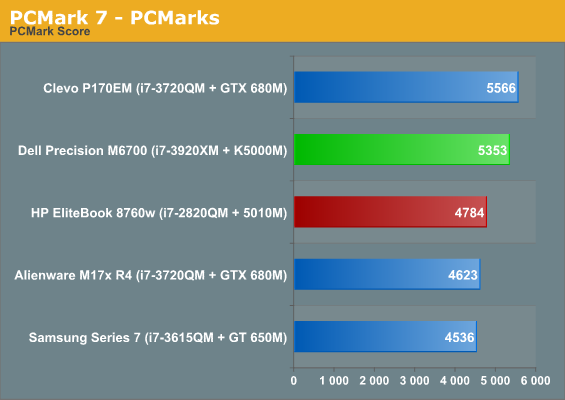

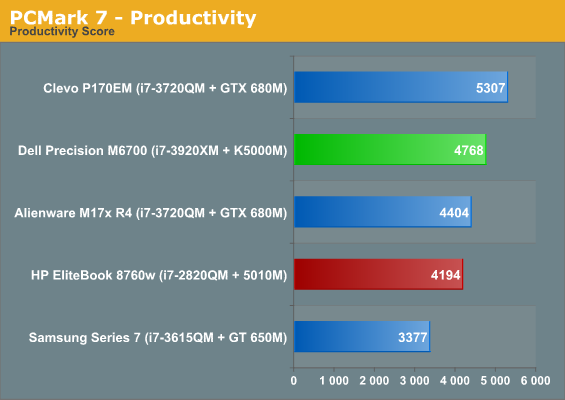
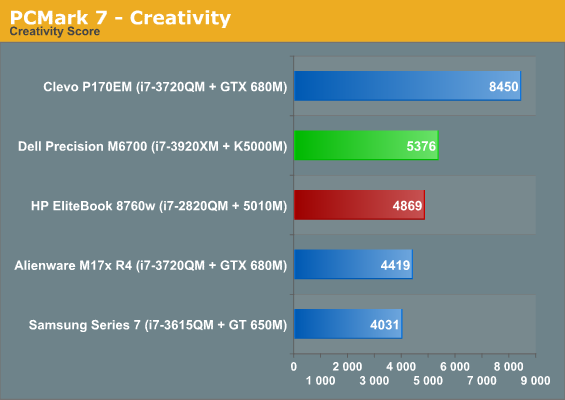
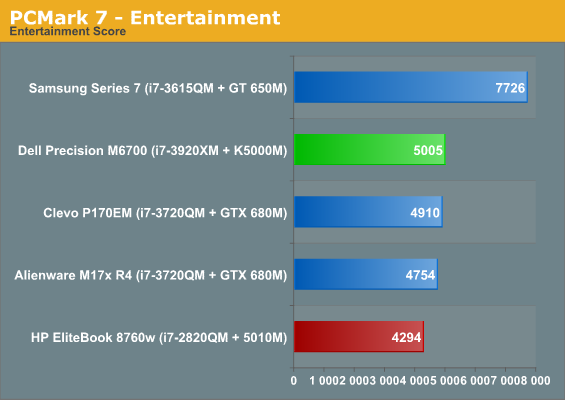
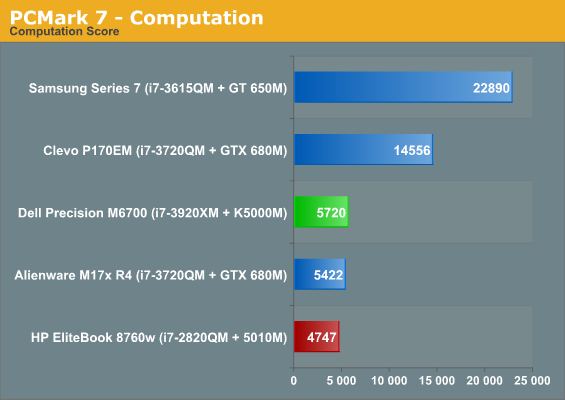
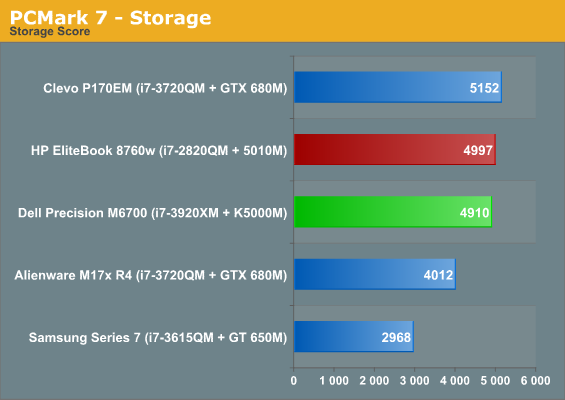
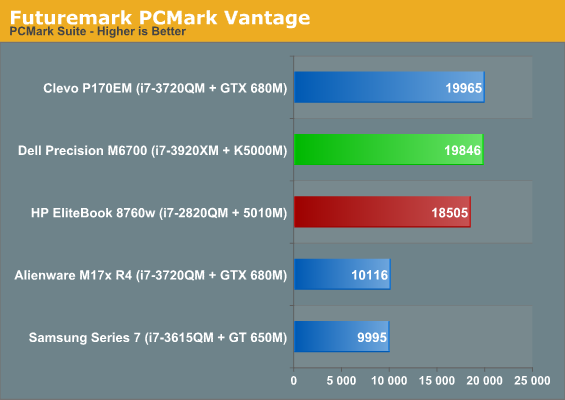
So what happened? It looks like PCMark slightly favors the Crucial m4 SSD the Clevo notebook uses. That's unfortunate, and frustrating, as once again PCMark shows it skews so hard towards the SSD that a system with a substantially more powerful CPU (lack of access to QuickSync notwithstanding), the Dell Precision M6700, is somehow eclipsed by a gaming notebook. But then I've been campaigning to remove PCMark from our testbed for some time now.
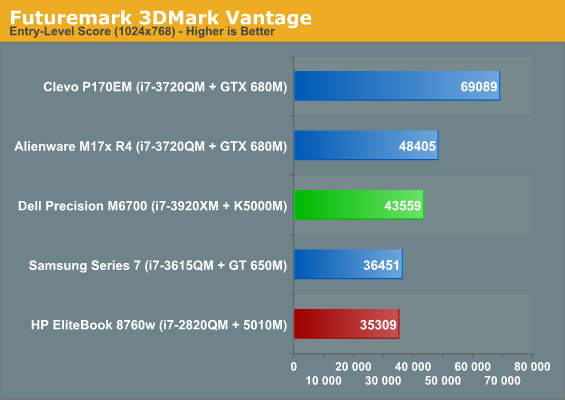
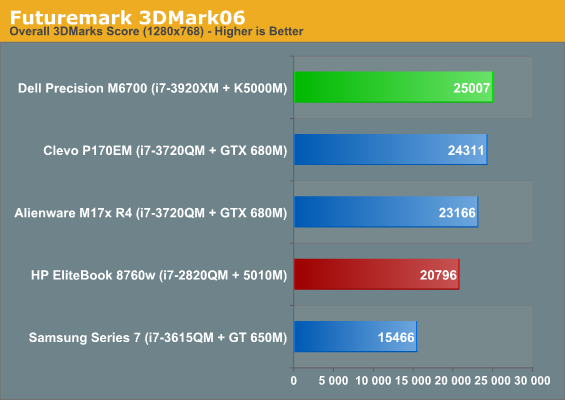
3DMark06 at least reveals the substantial performance of the i7-3920XM.
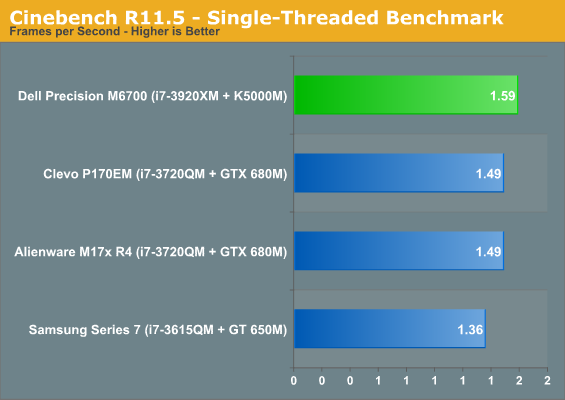
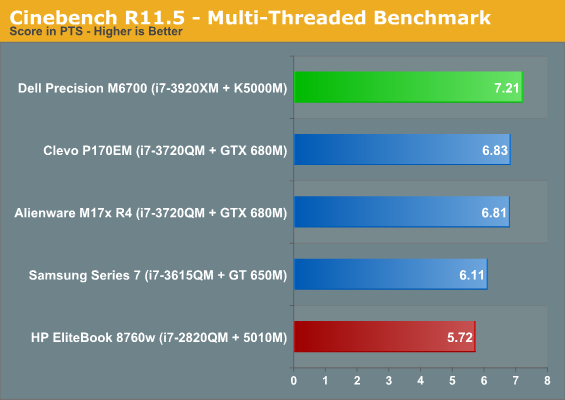
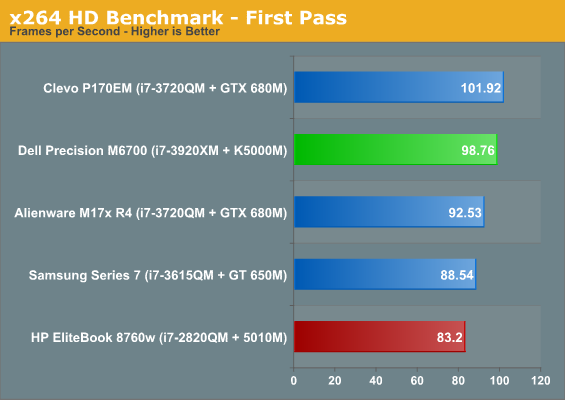

Inexplicably, Clevo's P170EM is able to produce better first pass results in our x264 benchmark, but in all other cases the M6700 is faster. For comparison sake, a stock i7-3770K (the one in the HP h9 Phoenix) is able to produce 100fps in the first x264 pass and 40.51fps in the second; that means that Intel's fastest (well, second-fastest now that the i7-3940XM is available) mobile chip is actually able to nip the heels of their fastest mainstream desktop chip. That also means that the 100MHz bump to the 3940XM is probably enough to get it to 3770K-level performance, which is frankly astonishing.










125 Comments
View All Comments
critical_ - Thursday, December 13, 2012 - link
It is necessary. My M6700 has a Core I7-3940XM, Quadro K5000M, 3 7200RPM HDDs and a mSATA SSD. When everything is going full blast there is quite a bit of power draw.The Lenovo W530 (another workstation) comes with a 170 watt power supply. It only has the K2000M which has a 55W TDP versus the 100W TDP of the K5000M. Remember, these are workhorses not aesthetic queens.
Gunbuster - Thursday, December 13, 2012 - link
You sure do a lot of complaining about aesthetics in this review yet fail to mention Dell offers a Covet edition in red with edge to edge glass screen...As for your HP obsession the M6700 demolishes it in nearly every one of your tests and cost 30% less (before any discounts that dell is well known for) Did HP give you the 8760W to keep or was it a really nice steak dinner? I don't understand at all.
cknobman - Thursday, December 13, 2012 - link
My company bought me a Dell m4600 which is a very similar model to the one reviewed just slightly smaller at 15.6 inches, has a i7-2720qm, and only a Quadro 1000M.I have been working with the laptop for a year now and it is by far the best workstation laptop I have ever used (of course most of the companies I've worked for are cheapskates and bought crap).
I love the design, 1080p screen, and portability is pretty decent. The unit is screaming fast (I am a .Net developer and it tears through anything I have thrown at it) and even plays games like BF3 (at 1600x900) and Diablo 3 (full 1080p) with no problem.
My only knock against the unit is the bottom access panel. It is held on with two cheap plastic tabs secured by screws and they break easily. If I am not careful I can accidentally slide the access panel open when carrying the unit around.
My favorite aspect of the system is even with a Quadro 1000M I can flawlessly run 4 1080p screens (counting the laptops own LCD) with no problems giving me tons of workspace.
hrrmph - Thursday, December 13, 2012 - link
The QM77 chipset only supports SATA 6.0Gbs on 2 ports.Both the Dell and HP mobile workstations have 4 drive bays. Which bays are SATA 6.0Gbs and which are SATA 3.0Gbs?
Or did Dell and / or HP add a third-party controller chip to bump up the number of 6.0Gbs capable drive bays?
-
critical_ - Thursday, December 13, 2012 - link
That is a limitation due to Intel's chipset. The primary and secondary hard drive bays are SATA 6.0Gbps. The mSATA slot, optical bay, and eSATA port are SATA 3.0Gbps.hrrmph - Thursday, December 13, 2012 - link
Thanks for the precision in your reply. Very helpful :)hrrmph - Thursday, December 13, 2012 - link
1920 x 1080 is a step backwards.I already have a 17" 1920 x 1200 laptop (albeit an ancient HP ZD8000).
Asus, Dell, HP, and Lenovo all need to pony up and try something new. How about an 18" 2550 x 1440 mobile display?
-
hrrmph - Thursday, December 13, 2012 - link
Where's the USB 3.0?Really! More than a decade later, both Dell and HP have USB 2.0 ports on their most exclusive machines?
And they b*tch about not being able to sell PCs.
Innovate da**it!
-
critical_ - Thursday, December 13, 2012 - link
There are 2 USB 3.0 ports on the right side of the laptop itself and 2 USB 2.0 ports. I'm glad USB 2.0 is included because not every rescue disc and OSs have drivers built-in to handle USB 3.0. On multiple occassions having USB 2.0 ports has saved me. Lenovo's ThinkPad workstation does this as well.hrrmph - Thursday, December 13, 2012 - link
Okay, let me restate it another way: There aren't enough USB 3.0 ports.This is regardless of how many USB 2.0 legacy ports they want to tack on it for disaster recovery.
Dell, HP, Lenovo, and most others cheap out here.
The exceptions are a few models of Asus and Toshiba. I have an all-USB 3.0 Asus machine with USB 3.0 x 3 ports and Toshiba offers USB 3.0 x 4 ports on some machines. But, those 'lesser' machines aren't in this lofty class of machines populated, really, only by Dell and HP.
Technically its possible to do the deed. If I understand it correctly, the Intel chipsets are able to handle USB 3.0 x 4, PLUS an additional USB 2.0 ports x 2, or more.
So there is no need to give up anything. But, the manufacturer's are stuck on offering Firewire and eSATA, at the expense of more USB 3.0.
The subject Dell and the HP machines are supposed to be the 'best of the best' desktop replacements / mobile workstations. So 6 x USB should be considered standard in keeping with the "we charge you more, but you get more" philosophy for these computers.
So manufacturers: Wire up those 4 ports of USB 3.0! Already!
2007 is calling and people want to know where their long awaited USB 3.0 ports are.
-